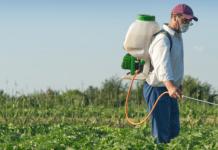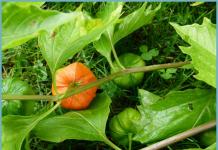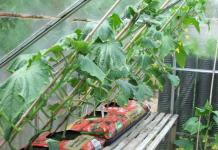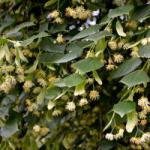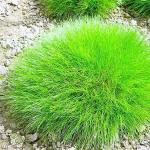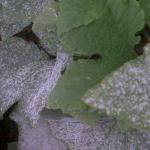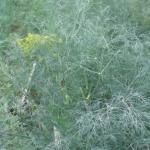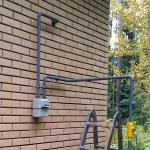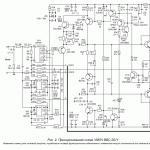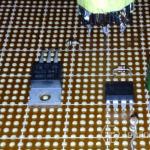In order to have fresh cucumbers on the table throughout the year, you have to use various protective structures. Depending on the materials and technical features of greenhouses, the terms of crop cultivation also differ significantly. Before you buy seeds, you need to understand the capabilities of your greenhouse and decide on agricultural technology.
Growing cucumbers in a greenhouse allows you to:
- significantly expand the growing season and harvest;
- create optimal conditions for the growth and development of plants and ensure maximum return per unit area;
- use the structural elements of the greenhouse to improve working conditions for caring for plants and harvesting.
With all the positive aspects, it should be noted that:
- the production of cucumber in a greenhouse requires quite high costs for materials, depending on the type of greenhouse, which increases the cost of production;
- requires constant disinfection of structures and soil, soil replacement, due to the accumulation of pathogens in an enclosed space;
- when planting pollinated varieties, it is necessary to ensure the presence of pollinating insects.
Types of greenhouses and their features
Various materials are used as the basis for the construction of protected ground, so the cost of greenhouses, their heat-saving characteristics, and service life vary significantly. The frame of greenhouses can be wooden or metal, differ in height and ability to support the weight of the coating:
- From polycarbonate.
Modern, durable, light enough material allows you to arrange greenhouses for early spring use. They hold heat well when heated. For winter operation, such greenhouses are not warm enough.
- From glass.
This coating material is quite heavy, so the frame must be strong. Glass greenhouses, with the right design and heating, can be used all year round.
- From film.
They build both high greenhouses and low temporary protective structures. Lightweight material allows the use of a simple frame made of wood, polyethylene, plastic pipes and thick wire. Such greenhouses are designed for spring use after thawing the ground, growing seedlings for open ground and getting earlier production. 
How to grow cucumbers in a greenhouse
Varieties
In greenhouses, various varieties are grown in terms of ripening, frost resistance, and pollination methods. It all depends on the technological capabilities of the protective structure and product requirements. In winter heated greenhouses, in the presence of pollinating insects, bee-pollinated varieties give the best result, otherwise self-pollinated varieties are planted.
From the point of view of product sales, short-fruited cucumbers are in the best demand, but in spring greenhouses, early-ripening, long-fruited varieties give a higher return in a short time.
landing conditions
Cucumber reacts negatively to low temperature and its sudden changes. Temperatures below +13°C are unacceptable for it, there is a risk of developing diseases, and during the fruiting period, fruits are not tied. The soil should be moist, but not waterlogged, daylight hours should be long.
After which crops is it better to plant
It is more difficult to rotate crops in a greenhouse than in open ground, since heat-loving tomatoes, cucumbers and peppers are often grown in protected ground. In periods free from their cultivation, green manure should be used as much as possible: grain, oilseeds.
Landing dates
Planting dates depend on the type of protective structure, the possibility of heating, the region, the weather conditions of the current year. In winter heated greenhouses, seedlings are sown for seedlings in the presence of additional illumination in November, and planted in a permanent place from the end of January. In spring greenhouses without heating, seedlings are planted no earlier than April - May, as soon as a suitable temperature level is established.
Lighting and temperature for growing
Cucumber develops well in lighted greenhouses, does not tolerate constant shading, but in hot, very sunny weather without shading, it can get burned.
Optimum temperature before fruiting:
- at night - not lower than + 17 ° С;
- during the day - not lower than + 20 ° С;
during the fruiting period:

Irrigation Features
Cucumber watering is carried out using a watering can, a hose, or specially arranged sprinkling or drip irrigation. It should be carried out in such a way as not to wet the plants, not to erode the root system, and to ensure uniformity.
Watering is carried out during the day, in clear weather, with closed windows, with warm water. The first watering after planting the seedlings is carried out after a few days, when the plants have acclimatized.
The technology of growing cucumbers in a greenhouse
Soil preparation for planting
Fertile, loose, rich in organic matter soils are best suited for growing cucumbers. To create favorable conditions for growing, organic fertilizers in the form of compost or manure are applied under the main plowing in the fall.
Depending on the fertility of the soil, the amount of organic matter is from 10 to 15 kg per 1 m² of greenhouse area. If organic matter has not been introduced since autumn, refueling can be carried out before spring digging, and only well-rotted manure can be used.
Before planting on 1 m² make:
- superphosphate - 2 tsp;
- wood ash - 2 tbsp. l.;
- "Agricola-5" (complex for pumpkin) - 2 tsp.
Ready-made nutrient mixtures for cucumbers are also added (up to 2 kg or in accordance with the manufacturer's instructions). A week before planting, the earth is abundantly watered with warm water, which warms up the soil and makes organic matter work. You can add 2-3 liters of Energen solution per 1 m² of soil.
Growing methods
Cucumbers are rarely sown with seeds in the greenhouse, and only in the warm season. To effectively use the protected ground area, seedlings are prepared in pots.
Seedlings at the age of 25-27 days with 4-5 leaves are planted in the main areas of the greenhouse. It is prepared both in the same greenhouses and in warmer seedlings and at home. 
Landing
Cucumbers are planted in ridges or ridges. The planting scheme is chosen depending on the width of the greenhouse, variety, and seedlings are planted in one or two lines with a distance between the bushes in a row of at least 40-60 cm. The distance between the ridges is left up to 80 cm.
The holes are prepared immediately before planting, their size should correspond to the size of the seedling pot. 1 liter of Effekton-O organic fertilizer solution is used per well (3 tablespoons per 10 liters of warm water). On average, 4 plants are planted per 1 m².
Watering
Must provide soil moisture up to 50-60% and air - up to 70-90%. On hot days, 4-5 liters of water are used per 1 m² (temperature + 20 ... + 22 ° C). Before flowering, watering is carried out after 2-3 days, and with the advent of ovaries, it is increased. It is better to water in the grooves so as not to expose the roots, or to carry out sprinkling.
loosening
Carry out after watering to provide the roots with access to oxygen. Loosening should be careful, shallow, so as not to damage the roots. With strong compaction, the soil is pierced with a pitchfork.
top dressing
It is carried out at all stages of development, but nutrition differs in composition:
- for seedlings (the first 10-15 days) - nitrogen, organic fertilizers are combined with mineral fertilizers: 1 liter of mullein and 20 g of urea are added to 10 liters of water;
- before flowering - phosphoric, 40 g of superphosphate is added to the previous solution;
- from the second half of the growing season - nitrogen-potassium, ammonium nitrate and potassium salt (3-10 g), boric acid (0.5 g), manganese (0.3 g), zinc sulfate (0.2 g) are added to liquid organic top dressing ).
The consumption of the solution is about 0.5 liters per adult plant. Watering is carried out before and after top dressing.
A good effect is obtained from foliar top dressing with a solution of copper sulfate, boric acid and potassium permanganate (2 g per 10 l of water).
From the video you can learn useful tips from an experienced gardener on how to grow greenhouse cucumbers.
Tying up
The most rational and common way to tie a cucumber in greenhouses is vertical tying. For its device, structural elements of the greenhouse are used. If their strength does not allow this, high (as far as the height of the greenhouse allows) and reliable metal or wooden supports are installed at the beginning and end of the row, between which a strong rope, wire is stretched, or a crossbar is placed.
To this U-shaped structure, with the help of long, soft ropes, each plant and the left side shoots are tied with a free knot.
Features of pollination
To get a good crop of cucumbers in a greenhouse, you need to consider that there are varieties that require artificial pollination (bee-pollinated) and self-pollinated (parthenocarpics). Bee-pollinated varieties are characterized by higher yields, early maturity and moderate light requirements. If it is not possible to keep bees or bumblebees in the greenhouse, then you need to choose self-pollinating varieties.
At the same time, it should be remembered that parthenocarpics require optimal temperature and humidity conditions for pollination, otherwise pollination may noticeably decrease.
Disease and pest control
In an enclosed space, especially with poor ventilation, high humidity and temperature changes, favorable conditions are created for the development of various diseases: bacterial, fungal, viral. Fighting them is not easy, so the focus should be on prevention:
- disinfect structures, soil, timely remove weeds, fruit bearing and diseased plants;
- use resistant varieties and treat seeds;
- ventilate the room and maintain the optimal ratio of temperature and humidity.
For disinfection, checkers "Fas", "Climate", preparations "Aktellik 2", "Bayleton", "Pharmaiod-3" are used.
Harvesting
During the period of active fruiting, cucumbers should be removed every 2 days. At the same time, injured and malformed ovaries are removed. Fruit picking is carried out early in the morning or in the evening. The work is done carefully, without pulling the plant, leaving the stem in place. 
Conditions for growing bunch varieties of cucumbers
At present, preference is given to growing bunch varieties of cucumbers, which are small-fruited and form several ovaries in each node. The number of ovaries on one bush can reach 500 pieces, they are distinguished by high productivity, excellent taste and commercial qualities.
In order for plants to be able to provide nutrition and form commercial greenery, it is necessary to maintain a high level of agricultural technology.
In order for growing in a greenhouse to bring moral satisfaction and a worthy result, it is important at all stages of development to strictly carry out agrotechnical measures and to prevent the development of diseases.
A variety is the leading link in technology, but the potential possibilities of a variety can be revealed only if its biological characteristics are taken into account in the technological process. There are bee-pollinated and parthenocarpic hybrids. For growing in film shelters, it is better to use parthenocarpic hybrids. Breeders have done a lot of work to obtain a parthenocarpic cucumber of universal use. New hybrids registered in the State Register with a well-pronounced parthenocarpy of universal use - Miranda, Zyatek, Well done, Masha, Yegorka, Kibriya, Spring, Artist, Athlete, etc.
Growing seedlings. The advantage when growing through seedlings is that they start harvesting 2-3 weeks earlier. Besides; the growing season is extended, the overall yield is increased and the reliability of cultivation is increased, since direct seeding in open or protected ground is associated with a certain risk. Low temperatures during germination, disease damage, seed damage by pests, etc. Highly organic soil is used to grow cucumber seedlings. Sawdust and peat in the ratio 1: 3 with the addition of biohumus and mineral fertilizers. The acidity of the soil should be within pH 6-6.5. Seeds can be sown directly in a pot to a depth of 1.5-2 cm or germinated in sawdust, and then pick out in the phase of cotyledon leaves. Temperature during seed germination 24-25 Shootings appear in 5-7 days. If the seeds were soaked in humate for 2-3 hours, seedlings may appear after 3 days. In the first period (2-3 days) after germination, seedlings are not watered. After picking, seedlings are moistened in the root part and mulched. The root system develops well in moist loose soil. An overdose of water leads to the death of the roots and diseases. The optimum temperature for growing seedlings in April - May is 20-24 0 C. Watering is moderate without waterlogging. Top dressing: the first in the phase of two true leaves; the second three days before landing.
1. For 1 liter of water - 1 g of urea and 2 g of crystallin with the addition of potassium humate (2.5 ml)
2. For 1 liter. water - 1.5 g of ammonium nitrate and 1.5 g. potassium sulfate with the addition of Na humate
Cucumber seedlings grown under glass must be hardened to ultraviolet rays 5-6 days before planting. To do this, seedlings are taken out to direct solar heating on the first day for 2-3 hours. Each subsequent day, the exposure is increased by 1 hour. Seedlings planted without hardening do not tolerate transplanting. The leaves burn, turn white, the root system grows much worse compared to the hardened one. The age of seedlings from the moment of germination should not exceed 25 days. A 25-day-old seedling grown under optimal conditions has: 4-5 true leaves, a height of 20-22 cm and a weight of 20-25 g. Before planting, the seedlings are watered with a solution of ammonium nitrate with potassium humate (per 10 liters of water 2 g. Ammonium nitrate and 25 ml potassium humate). Recently, on the basis of "humates" for dressing seedlings and adult plants, a variety of liquid fertilizers have been used. Many fertilizers contain macro and micro fertilizers with the addition of humic acids, which stimulate the growth of the root system and have a beneficial effect on the growth and development of plants.
Soil preparation for the greenhouse. To obtain high yields of cucumber, loose, highly organic soils are prepared. The basis of such soils is peat. To prepare the soil mixture, peat must be limed, as it has a high acidity. On acidic soils, cucumber grows poorly. It develops better when the reaction of the soil solution is close to neutral ( pH 6.2-6.8). The second component is humus. Straw manure can be used instead of humus. The third component for the preparation of the soil mixture is sod land. In practice, they often use fertile, structured, with good physical properties, not infected with dangerous diseases and pests, field or garden land. Nitrogen fertilizers are applied during the formation of ridges a week before planting. The soil in the greenhouse can be used for 5-6 years or more. To maintain the loose structure of the soil, sawdust or straw cutting is introduced annually in the spring in the amount of 1.2-1.5 m 3. Loosening material is prepared in the fall. It is known that sawdust or straw cutting when applied, bind nitrogen and turn it into an inaccessible form for the plant. Therefore, a prerequisite is the addition of nitrogen fertilizers. For 1 m 3 of sawdust, 2 kg of urea or 3 kg of ammonium nitrate are added. When mixing fertilizers with sawdust, it is necessary to moisten them. Cooked sawdust is covered with a film and left for the winter. In the spring they are carried to the beds and dug up. Humus, high-moor peat can be used as loosening material.
Landing scheme. The yield of vegetable crops, including cucumber, depends on the intensity of photosynthesis, especially in the greenhouse. Plant illumination has a major influence on photosynthesis. To make the most optimal use of plant lighting, it is necessary to correctly position the greenhouse and effectively place the plants in it. The greenhouse is placed from east to west on the north side, it is desirable to have protection from the winds. To tie a cucumber across the greenhouse, pull the trellis. The distance between the trellis is 50 cm. Between the two trellises is 100 cm. The indicated trellis can be used not only for cucumber, but also for tomato, pepper.
Seedlings of hybrids are planted at the rate of 2,7 plants per 1 m 2, for other varieties, the planting pattern changes slightly. Landing pattern 2 100+50 x 40 cm. Plants are planted strictly under the trellis in dug holes. The distance between plants is 40 - 50 cm. The wells are watered with warm water before planting. Prepared seedlings are planted in holes and covered with soil. The root part of the seedlings is mulched with dry soil or peat. Plants are not watered after planting. Moisture in the soil is enough for 2-5 days, depending on the temperature. The first watering is carried out after 2-3 days in the root part with warm water (water temperature 25-30 ° C) consumption of 100-150 ml. on the plant with the addition of humate.

temperature and nutrition. The day before planting, seedlings are treated with "EPIN" for better adaptation to adverse conditions. The temperature of the soil on the day of planting should not be lower than 18 ° C. If the temperature of the soil in which young plants are planted is below 14-16 ° C for a long time, the seedlings will wither and may die. In the future, surviving plants have a weak root system and will not be able to provide nutrition to the formed ovaries. Many plants can "pupate", a bunch of predominantly female flowers is formed at the point of growth and the tip of the young plant stops growing. The optimum temperature in the first week after planting is 20-22 ° C. A week later, when new leaves have formed on the seedlings and the growth of the root system has intensified, the temperature can be reduced to 18-20 ° C. . From the moment they enter the harvesting phase, the reaction of plants to temperature changes. The optimum temperature for obtaining the maximum yield shifts from the region of elevated temperatures to the region of lower ones. This is explained by the fact that at elevated temperatures, Zelentsy grow so quickly that there is strong competition between them for assimilants. The consequence of this is the uneven formation of fruits: after harvesting the cucumbers from the lash, there is a long pause, which can negate the benefits of an early harvest. In addition, in such cases, early aging of plants often occurs. Thus, in order to obtain early and high yields, a high temperature is recommended before harvesting, followed by a decrease in it. Care after planting, within 10-12 days, consists in a slight watering in the root part. At this time, it is important to grow the root system. Overwatering can cause death and rotting of the roots. The root system grows well and develops in loose, well aerated soil. Increase watering with the growth of the first greens. Feed the plants begin three weeks after planting.
Plant formation. The main task of the formation is to obtain the maximum yield by controlling the growth rate of the vegetative and generative sphere of the plant. Optimal formation allows you to redistribute the assimilation products among the organs of the plant, rationally use the volume of the greenhouse, create a more favorable regime of illumination and humidity. Before starting the formation, the plant is twisted around the twine. First, the twine is tied with a free knot on a trellis wire, then its second end at a height of 20-30 cm from the soil surface is fixed with a free loop on the plant. Often mistakes are made when tying, which subsequently harm the plants. The main ones are: fastening plants to a highly stretched twine, which, when the trellis wire vibrates, can damage the root system up to tearing it out of the soil; insufficient size of the loop when tying the plant - as the stem thickens, the twine will cut into it, which leads to a decrease in the flow of assimilation products to the root system and its weakening up to death.
In the first period after planting seedlings, it is necessary to form a root system and create conditions for vegetative growth. Therefore, when twisting in the lower 3 nodes, all ovaries and shoots are removed. Due to low temperatures, individual plants can "terminate" and stop growing. To create vegetative growth in such plants, the ovaries from the axils of the leaves are removed to the point of growth. In the lower tier, the shoots are pinched on 1 leaf and one fruit is left, in the nodes of the middle tier, on 2 leaves, and in the upper tier, 3 leaves. The top of the plant is carefully wrapped around the wire trellis at a distance of 40 cm, lowered down and pinched at a distance of 15-20 cm from the trellis. Two shoots are lowered from the upper nodes of the main lash. When tying, it is necessary to place all the peaks in one direction, and on a parallel trellis in the opposite direction.
Harvest. The fruits reach harvesting maturity 12-15 days after flowering in spring and 7-10 days in summer. Zelentsy is harvested 2-3 times a week with a length of no more than 12 cm, and a diameter of no more than 5 cm. Overgrown fruits left on the plant prevent the development of new ovaries and reduce the yield. Especially if the fruits are pollinated and seeds are tied in them.
10.Characteristics of some varieties grown in the enterprise.
As you know, cucumber is a vegetable crop that grows and bears fruit well only in a place that is well lit and warmed up during the day. It is desirable that the area where the cucumbers are planted is protected from the wind. This is a culture whose root system is extremely sensitive to adverse influences and factors. Today, cucumbers are successfully grown in open ground or indoors: panic, greenhouses, etc.
The soil is also of great importance for the effective cultivation of cucumbers in the ground. Do not choose heavy, cold and waterlogged soil for planting seeds. They thrive best in light, fertile soils. Reservoirs located near the site have a very favorable effect on the cultivation of cucumbers in the ground. From the water, the air becomes humid, and the air temperature during the day is more stable.
The soil, which is rich in humus, loamy, does not require deep cultivation, is the best place where you can grow a good crop of cucumbers. Drained peat bog, chernozem soil, cultivated non-acidic lands are best suited for growing cucumbers in the ground. It is necessary to take into account what grew on this piece of land last year. It is best to plant cucumbers after tomatoes, potatoes or cabbage. Planting after plants of the pumpkin family (actually, the pumpkin itself, squash, zucchini, watermelons and melons) is not recommended. there is a great danger of crop death from pests and diseases.
But when using the right agricultural technology, it is possible to grow a cucumber on both heavy, clayey and light sandy soil. To do this, various loosening materials, such as manure, sawdust, rotted leaves or compost, must be added to clay soil in the fall. If you use a peat bog for loosening, but before applying it to the soil, it must be limed. In order to finally prepare the soil for sowing cucumbers in the fall, autumn plowing is necessary. In order to improve plant nutrition in spring and saturate the soil with carbon dioxide, it is recommended to apply fresh cow manure (5 kg/m2) annually to the site.
Seed preparation
Seeds that were collected 2-3 years ago are optimal for sowing, because. plants grown from such seeds produce female flowers earlier, therefore, they are the first to bear fruit. For good results, seeds can be treated by soaking in potassium permanganate (20 minutes in a 0.5% solution). It will not be superfluous to harden with a variable temperature of +20 - during the day and -2 - at night.
For sowing in the middle lane and in the north, dry seeds are used. In these areas, early sowing is usually practiced, because. the time for the growth of this vegetable crop is limited due to weather conditions. And if you plant soaked or germinated seeds, then if there are frosts, the seeds may freeze or rot.
In normal climates, seeds are sown sprouted or in moist soil. Deadline - end of April - beginning of May. You can sow the seeds in several beds with an interval of 2 weeks, and then you will get a "conveyor" crop.
Seeding and watering methods
For growing cucumbers in the ground, various seed sowing technologies are used - trellis, free or in combination with rock plants. 
Double seeding. The scheme of such sowing is as follows: 90 x 50 x 50 cm.
Wide row sowing. Row spacing should be 70 - 90 cm with 50 - 60 cm in rows.
When trellis planting, the seeds are sown according to the scheme 80 - 90 + 50 + 50 x 20 - 25cm, i.e. 2 ribbons of 50 cm, plants in a row after 20-25 cm, the distance between the ribbons is 80-90 cm.
Backstage can usually be replaced with tall crops, such as corn, Brussels sprouts.
After seed germination:
- constant loosening of the soil, mulching with sawdust, straw chopping can be used;
- regular watering and destruction of weeds;
- Fertilizing is necessary 2-3 times (80 g of superphosphate, 30 g of potassium chloride per 10 m2 of the sown area, or manure diluted 1:10).
It is not recommended to make sudden changes in soil moisture, air, because. from this, bitterness develops in the fruits of cucumbers. To do this, water the culture should be 1 time in 3 days. The norm of water per 1 m2 is 2.5 liters. And before the flowering of cucumbers, the soil should be dried a little (this is how female, “fruitful” flowers are laid more). When flowering is almost over, continue watering as usual.
During the day, you can do the so-called "moisturizing watering" - 0.5 liters per 1 m2, which increase the yield of cucumbers.
The first crop of cucumbers (with proper watering and care) can be harvested already 50 days after the seeds have sprouted. It is necessary to collect cucumbers daily, this will improve the yield. When collecting, you need to be careful not to damage or injure the lash of the plant, because. they may dry out.
Growing cucumbers indoors
The most well-known method of growing cucumbers indoors is greenhouse cultivation.
Growing cucumbers indoors in a greenhouse is a fairly profitable and rational business, especially in winter. For a good harvest, it is necessary to equip the greenhouse with a heating system and lighting. Lighting should be bright, it is possible to use both incandescent lamps and other light sources.
The greenhouse can be made of glass, transparent plastic, as well as stretched film. For the heating system, a stove can be used, which is heated both with wood and coal, as well as gas heating.
In order not to delay the germination of seeds and the development of seedlings, it is necessary to plant seeds or seedlings in warm soil. For seed germination, it is necessary to warm up the greenhouse to 25 degrees, and after removing the film - 17 degrees.
Seedlings are planted in the greenhouse that have been hardened, not stretched out, which has 4-5 leaves, 25-30 days old. In the winter greenhouse, seedlings must be planted in the first half of February, and in spring greenhouses - in the first half of April.
The layout of the beds for planting cucumbers is 120 x 30 cm, it provides good heating and soil aeration. Before planting seedlings, the soil must be moistened. Plant seedlings so that the edge of the pot protrudes slightly above the ground. Plants are immediately tied along a vertically stretched trellis, which must be tied to a wire. Tapestries are made of twine with a length of 2 m, one end is attached to the wire, and the other is tied to the plant under the second or third sheet.
After the plant grows to 8-9 true leaves, the formation of a bush begins. New branches are completely plucked at the beginning of their formation. In the next 4-5 nodes, lateral shoots must be pinched on one cucumber and one leaf. Above the 5th node to the wire, shoots growing from the side should be pinched for 2-3 leaves and fruit.
Among all types of entrepreneurial activity, the business of industrial cultivation of cucumbers in a greenhouse occupies a worthy place among others common in our country. The presence of fertile soils, the mild climate in many regions, the affordable and uncomplicated technology of professional cultivation, government support - all this attracts citizens who want to try themselves in this way of earning. Of course, caring for cucumbers requires effort and is fraught with some difficulties - creating certain conditions in the greenhouse, preventing the development of diseases, but if all the basic rules are followed, it can provide a stable income.
The sequence of actions when organizing a business
Before deciding to invest in growing cucumbers in the winter in a greenhouse for sale, you should familiarize yourself with the features of the process and the main points that this type of activity has. In addition, it is necessary to think over in detail all the necessary steps for organizing and draw up a business plan for growing cucumbers, which, as a rule, consists of the following main stages:
- Determination of the region for cultivation. Here it is necessary to understand that a more severe climate implies high heating costs in the cold season, and cultivation in the southern regions will give a lower cost, but at the same time, significantly increase the potential number of competitors;
- Choice of growing method and type of greenhouse;
- Determining the optimal varieties depending on the type of soil, the desired yield, the quality of vegetables and the time of their cultivation;
- Business registration;
- Equipment for greenhouses, heating and irrigation systems;
- Purchase of basic and auxiliary materials;
- Sales organization and customer development.
Ways to grow cucumbers and types of greenhouses

There are the following ways to grow cucumbers in greenhouses:
- Depending on how you plan to receive seedlings:
- Self growing from seed. This method significantly increases the profitability of the business, but, in some cases, if the necessary conditions are not met, it leads to the death of plants and the loss of invested funds;
- Purchase of seedlings. This method assumes the absence of the process of planting seeds and forcing seedlings. The method is bad in that it significantly increases the cost of grown crops, although it reduces the risks of production.
- Depending on the use of supporting structures:
- Horizontal, when the plant is completely on the ground. In this case, raw materials and time are saved, but more space is consumed. It is mainly used for open ground;
- Vertical. It consists in the use of supports for vegetable bushes - trellises. This method allows you to plant the maximum possible number of roots per unit area (about 25 thousand bushes per hectare).
The construction of a greenhouse for growing cucumbers all year round involves a preliminary selection of the type of such a structure that will be best suited to the existing conditions. Alternatively, you can use the following, widely used for cucumbers:
- Innovator Premium:

- By Meatlider:
- Such a greenhouse is suitable for growing cucumbers all year round in the more southern regions of the country, since in a harsh climate its configuration will not provide the ability to maintain the required temperature;
- The main difference from other structures is the presence of a gable roof to provide ventilation inside the greenhouse.
- Greenhouse "Farmer":
- It has one significant difference - a reinforced frame, thanks to which it is possible to grow cucumbers in a winter greenhouse of this type, even in regions with heavy precipitation in the form of snow;
- It has an increased light transmission capacity, which is very important for obtaining a high yield of cucumbers;
- Such designs are used when industrial greenhouses are being built for growing vegetables in large volumes. They allow significant savings by installing one heating and irrigation system over a large area.
The registration process for the cultivation of cucumbers
In the process of official registration of entrepreneurial activity, one of the following types of legal form of business can be used:
- LPH - personal subsidiary plot. It is the best option for start-up entrepreneurs who do not have the opportunity to invest a large amount of funds, especially at first. In principle, this form of ownership does not involve running a business and, as a result, is not taxed. LPH can be used as a "training stage", at which you will understand whether you can do this business and whether this way of making money is right for you. The only drawback is the limited area of land allocated for such activities - 2 hectares;
- KFH is a peasant farm. This type is well suited for doing business with a joint investment of money with one or more partners. By its principle, it is similar to a limited liability partnership, but it involves a simpler reporting system. In addition, the CPH provides for the possibility of obtaining government subsidies and a large number of tax benefits;
- An individual is an individual entrepreneur. This form of ownership already implies significant cultivation volumes and allows obtaining permits of any level, as well as concluding agreements and contracts, observing the rules prescribed in the legislative acts of the Russian Federation.
Necessary varieties for growing cucumbers
 In order to understand what conditions to provide for growing cucumbers in a greenhouse and what kind of climate to create, you need to decide on the varieties of crops that you will grow. In any case, self-pollinating varieties of vegetables are purchased for the greenhouse, because otherwise you will not get a crop at all. For artificial conditions, the following varieties of cucumbers are suitable:
In order to understand what conditions to provide for growing cucumbers in a greenhouse and what kind of climate to create, you need to decide on the varieties of crops that you will grow. In any case, self-pollinating varieties of vegetables are purchased for the greenhouse, because otherwise you will not get a crop at all. For artificial conditions, the following varieties of cucumbers are suitable:
- Herman - a hybrid variety that gives a high yield - up to 20 kg per square meter of planting;
- Courage is an early hybrid that feels great in greenhouse conditions. Gives a large amount of harvest and is popular among buyers because of its pronounced taste.
If you are going to start growing early cucumbers in a greenhouse, then the following varieties are best suited for this:
- Calendar;
- City cucumber;
- Zozulya;
- Connie;
- April;
- goosebumps;
- Alekseich;
- Benefit.
It is worth noting that each existing variety has its own growing characteristics and should be selected according to its main characteristics, the most suitable for a businessman.
Features of growing cucumbers in greenhouse conditions
 The technology for growing cucumbers in a greenhouse is somewhat different from cultivating them in open ground and includes the following actions:
The technology for growing cucumbers in a greenhouse is somewhat different from cultivating them in open ground and includes the following actions:
- Pre-germination of seeds.
- Soil preparation for planting. There can be various discrepancies in the composition of the soil - each experienced entrepreneur has his own secrets and methods that they are not very willing to reveal. The basic composition suitable for such a culture is the following:
- Two pieces of peat;
- Two parts of humus;
- One piece of old sawdust;
- Wood ash (3 tablespoons);
- Nitrophoska (1 tablespoon).
- Planting germinated seeds in the ground to a depth of 2 cm.
- Maintaining the temperature at +25 degrees until the period of germination. By the way, a warm greenhouse is one of the main conditions for obtaining a good harvest, since cucumbers are quite heat-loving plants and will not even give ovaries at low temperatures.
- Watering and feeding plants.
- Planting plants in a permanent place of growth. The conditions for growing cucumbers in a greenhouse require a certain distance between each other - at least 20 centimeters, and between beds from 0.9 meters.
- Providing plants with the necessary conditions for normal growth. First of all, you should pay attention to the lighting of the greenhouse, since the lack of light, especially in winter, can cause a significant stunting, poor ovaries and, as a result, a very small yield of the finished product. During the day, the temperature should be maintained at +25 - +30 degrees, and at night - not lower than +15. During the growing process, it is recommended to fertilize with a solution of mullein or chicken manure, although new technologies already involve the introduction of artificial fertilizers, but nevertheless, plants feel much better on such natural plants.
- Tie plants to supports as they grow.
- Harvesting, storage and sale.
Start-up costs, profitability and marketing
The approximate costs that will need to be incurred when growing cucumbers in a greenhouse for sale are as follows:
- Construction of a greenhouse - from 500 thousand rubles;
- Heating system equipment - from 100 thousand rubles;
- Purchase and installation of a lighting system - from 500 thousand rubles;
- Purchase and installation of an irrigation system - from 50 thousand rubles;
- Purchase of seeds, fertilizers, auxiliary materials - from 200 thousand rubles.
Thus, the total amount of capital investments can be from 1.35 million rubles.
The profitability of such a business is at around 15-20% and, on average, capital investments pay off in one to two years.
In order to secure the maximum amount of profit, it will be necessary to organize a system for marketing finished products. The sale of grown cucumbers can be carried out in the following ways:
- Lease in large quantities to wholesale companies specializing in the sale of vegetables;
- Sell in markets, shops, supermarket chains and small shops;
- Organize retail sales from the warehouse;
Equip your own outlets. This method, of course, will require additional investments and hiring sellers, but it will allow you to set a higher selling price for the cucumber.
Cucumber is one of the oldest popular vegetable plants in Ukraine, Russia, Belarus, Moldova. Cucumber fruits are consumed fresh, they are pickled, canned, salted, used in various types of assorted dishes, salads, sandwiches, used in the preparation of first courses (pickle, okroshka), various types of stews, sauces.
Cucumber is used in specialized diets for obesity, polyarthritis, spurs, diseases of the kidneys, prostate gland, hypertension, diseases of the liver, thyroid gland, and skin diseases.
The plant is known in cultivation for 3-4 thousand years. Its homeland is Southeast Asia. In Ukraine and Russia, the first descriptions of cucumber are found from the 16th century. Spain boasts the largest area under greenhouse cultivation of cucumber - 4 thousand / ha. Plants ripen here with a potential yield in greenhouses of 60-90 kg/m2. Most cucumbers (g/person/day) are consumed in China (48.7), Israel (47.5), Ukraine (40.4). Culture ranks third in terms of imports to the EU countries. The largest importers of cucumbers are the Netherlands and Belgium.
The growth and development of a cucumber plant is predetermined by: temperature, humidity, light, and nutrients. With their optimal ratio, high productivity, quality, resistance to abiotic and biotic factors are formed. Under such conditions, seedlings appear after 3-6 days, a real leaf - on the 5-6th day after germination, the second leaf is formed after 8-10 days, the next - after 3-4 days. Further, the sheet can be formed daily or 2 sheets per day. Flowering begins 30-40 days after germination. The plant develops vegetatively (height, leaf size and quantity, weight of the plant) and generatively (number of flowers, fruits of their placement). The flowering period lasts 90-120 days. Plants may produce few male flowers (<50%) – женский тип, 50% – промежуточный тип, более 50% – мужской тип. Как правило, гибриды F1 и женского или промежуточного типа.
The optimum temperature for growth and development is +25 ... +30 ° C during the day, +15 ... +19 ° C at night. The growth temperature of the root system is +19 ... +20 ° C. Pollen germinates better at a temperature of +26 ... +29 ° C. The optimal light intensity is 15 thousand lux. Optimum air humidity is 80-90%, soil - 80%. Irrigation dose 1-3 l/m2. Up to 200 m3 of water is needed to form 1 ton of crop. The amount of CO2 in the air should be at the level of 0.3-0.6%. For 10 tons of harvest, a cucumber takes out 27.5 kg of nitrogen, 14.6 kg of phosphorus, 42.2 kg of potassium. Soil acidity (pH) 6.4-7.0 is required. The optimal amount of organic fertilizers is 6-8 kg/m2.
Successful growth and development of cucumbers is provided by:
Adjusting the load of fruits on the plant;
- Plant formation system;
- Introduction of beneficial microorganisms into the zone of the root system;
- Growing F1 hybrids with a strong root system
- Decreased concentration of the nutrient solution;
- The use of growth and development stimulants.
Let's get to technology
Various designs of greenhouses, periods of plant growth dictate specific requirements for certain elements of technology. Of course, the basis of technology is a hybrid, selected according to the crop rotation and the type of protected ground.
Winter-spring period
 Cucumber bee pollinated. Sowing is carried out on November 24-26 in special boxes with a selected substrate to a depth of 2-3 cm. Sowing is mulched and covered with a perforated polymer film.
Cucumber bee pollinated. Sowing is carried out on November 24-26 in special boxes with a selected substrate to a depth of 2-3 cm. Sowing is mulched and covered with a perforated polymer film.
The substrate temperature is +24 ... +25 ° C. With the emergence of seedlings, the temperature is reduced to +19 ... +20 ° C. The film is removed. Seedlings dive into mineral wool cubes - 10x10 cm. Seedlings are watered with a nutrient solution with a concentration of 1.5-2.5 mS / cm (milisiemens, / mS / cm is equal to 700 g of salts per 1 liter of solution). When growing seedlings, it is stirred 20 pieces / m2. Seedlings are illuminated around the clock at a temperature of +22 ° C, at night +20 ° C. During the period of plant placement, the temperature is maintained at +20 ° C - during the day, +18 ° C - at night. Planting of seedlings, 30 days old, begins on December 20 with the placement of 2.5-2.8 pcs/m2.
Plants tie up and remove male flowers at the bottom of the stem. The formation of the plant begins after the appearance of the 9-11th leaf.
The plant is formed in this way: at half the height of the plant (up to 1 m), shoots are left, which are grafted over the 3-6th leaf above the wire, wrapped 2-3 times around it, the side shoots are lowered down, grafting them at a height of 1 m into the soil . Each side shoot, in order of placement, is grafted over the 2nd, 3rd, 4th leaf. On pollinating hybrids, all female flowers are removed, lateral shoots are grafted over the 2-3rd leaf, in the upper shoots - over the 3-5th leaf. The plant is formed within 60-75 days. Lateral shoots should not thicken plants, their length is not more than 15-20 cm. Dry leaves are removed from below. When thickening, you can remove the leaves in the upper shoots, above the fruits. 9-11 fruits are left on the main stem. At the same time, 2-3 fruits should be formed. To intensify the load with fruits, increase lighting, CO2, and nutrition.
At the beginning of growth and development, the concentration of the nutrient solution on sunny days is 2.2 mS / cm, gloomy - 2.4 mS / cm. The drainage yield is 20-25%. At the beginning of fruiting, the concentration of the solution is increased: on sunny days, 2.4-2.6 mS / cm, gloomy - 2.6 mS / cm. During the period of mass fruiting, the concentration is again reduced.
When irrigating, the calculation of water is 100 ml per 10 J of solar radiation. The microclimate is regulated by temperature and ventilation.
After picking the fruits, the temperature is reduced to +17 ° C. During the period of mass fruiting, the temperature is kept at +22 ° C, at night +18 ° C. Fruit picking is carried out every other day.
By adjusting watering, nutrition, lighting, CO2, it is possible to direct the development of the plant towards generative or vegetative development.
The presence of a pollinator in the amount of 10-15% of the main ones increases the yield, 2500-3750 plants per 1 ha. Improves pollination, and therefore the harvest, the use of bees or bumblebees. One bee colony is placed per 1000 m2.
When planning the amount of mineral fertilizer for the nutrient solution, you can proceed from the following recommendations:
N-85-170, R-230-450, K2O-130-260, Ca-105-210, MPO-80-130 kg / Ga. To this should be added (kg d.r. / ha): boron - 1.0, iron - 3.0, manganese - 3.0, zinc - 2.0, copper - 3.0, molybdenum - 0.3.
During the growing season, treatments are carried out against pests: whiteflies, ticks, aphids, thrips, mosquitoes (actellik, aplaud, confidor, mospilan, Talstar).
spring-summer period
 General approaches to the technology of growing seedlings, plants similar to those described above. Only external factors change, taking into account which the amount of water, nutrition, CO2 supply is adjusted, the timing of the work changes. During the formation of plants, female flowers emit up to 3-4 leaves of the main stem, as well as side shoots. On the next 2-3 nodes, lateral shoots are grafted over the 1-2nd leaf, and later - over the 2-4th leaf. The top is wrapped around the wallpaper wire and lowered down, grafting at a distance of 80-100 cm from the surface of the substrate.
General approaches to the technology of growing seedlings, plants similar to those described above. Only external factors change, taking into account which the amount of water, nutrition, CO2 supply is adjusted, the timing of the work changes. During the formation of plants, female flowers emit up to 3-4 leaves of the main stem, as well as side shoots. On the next 2-3 nodes, lateral shoots are grafted over the 1-2nd leaf, and later - over the 2-4th leaf. The top is wrapped around the wallpaper wire and lowered down, grafting at a distance of 80-100 cm from the surface of the substrate.
For cultivation, hybrids with a friendly formation of a high yield are needed. Nutrition is directed towards generative growth; removing leaves, grafting growth points, often harvest fruits, adjusting the rate of crop formation. A good effect is given by foliar feeding and the use of growth substances.
In the summer, it is necessary to carry out ventilation and carry out refreshing watering - 0.5-1.0 l / m.
Withstand the plant density of 2.2-2.5 pieces/m2, depending on the habitus of the hybrid.
When forming, they adhere to the position: 1 fruit - 1 leaf, 2 fruits - 2 leaves, 3 fruits - 3 leaves. Mineral nutrition level: N-80-100 mg/l, R-15-20, K-160-180, Ca-160-180, Mg-50-60 mg/l. In ground greenhouses, apply manure from autumn - 200-250 t / ha. During the growing season, it is necessary to control the humidity of the soil and air. Soil temperature +22 ... +24 ° C, air: +21 ... +23 ° C during the day, +18 ... +19 ° C at night.
Pest and disease control is carried out.
With intensive cultivation technology, fruits are harvested daily. It is necessary to plan the technology in such a way as to get the maximum yield before the fruit arrives from the open ground.
We select varieties and hybrids
Ukrainian selection:
F1 Xana, F1 Slobozhansky, F1 sheepskin, F1 Connoisseur, F1 Sage, F1 Granddaughter, F1 Star, F1 Souvenir.
For closed ground conditions, Russian selection:
firm "Gavrish" - F1 Athlete, F1 Bobrik, F1 Casanova, F1 Courage, F1 Cadet, F1 Orlik, F1 Trembita, F1 Shchedryk;
firm "Manul": F1 Buyan, F1 Hercules, F1 Ermine, F1 Lord, F1 March, F1 Saltan, F1 Farmer.
Parthenocarpics of Russian selection: F1 Amur, F1 Antoshka, F1 Courage, F1 Buran, F1 Navruz, F1 Emelya, F1 Angel, F1 Alena, F1 Voyage, F1 Malvina.
Among the hybrids of foreign selection recommended for cultivation are:
Bejo Zaden B.V.: F1 Alex, F1 Bejo 2640, F1 Atlantis, F1 Asterix;
Enza Zaden: F1 Socrates, Excelsior, Tristan;
Nunems B.V.: F1 Angelina, F1 Ajax, F1 Delpina, F1 Parker, F1 Crispina, F1 Flamingo, F1 Athena;
Rijk Zwaan: F1 Harmony, F1 Presto, F1 Vocal, F1 Motive, F1 Mendeth, F1 Componist;
Shingeta Shizu: F1 Othello, F1 Pasalimo, F1 Ofix;
De Reuther Shizu: Picobello, F1 Prints, F1 Atlanta;
Everyone involved in the cultivation of cucumber must select a variety, a hybrid for the specific conditions of the region or the type of greenhouses, culture change. For the southern regions of Ukraine, it is necessary to select hybrids created in the conditions of the south, for the northern regions - in the conditions of the north. One way or another, each variety must be evaluated for the manifestation of the desired traits in the specific conditions of your production.
We provide a specific description of some varieties and hybrids of cucumber grown in Ukraine under greenhouse conditions (table 1).
Table 1. Characteristics of some varieties and hybrids of cucumber grown in Ukraine under greenhouse conditions
| Name | Originator | Total yield, t/ha | Fruiting period, days | Damage,% | |||||
| transfer-sporosis | powdery mildew | intermission | viral diseases | aphids | |||||
| Smushkovy F 1 | NDNC s/gr | 32 | 65 | 50 | 0 | 0 | 0,2 | 0 | 0 |
| F1 Connoisseur | NDNC s/gr | 34 | 75 | 52 | 0 | 0 | 0 | 0 | 0 |
| Sage F 1 | NDNC s/gr | 52,4–54,5 | 70 | 55 | 0 | 0 | 0,3 | 0 | 0 |
| Granddaughter F 1 | NDNC s/gr | 27,0–28,0 | 52–54 | 58 | 0 | 0 | 0,1 | 0 | 0 |
| Zoryany F 1 | NDNC s/gr | 24,0–27,6 | 54–56 | 59 | 0 | 0 | 0 | 0 | 0 |
| Xana F 1 | ІOB NAAN | 23 | 53–54 | 50 | 0 | 0 | 0 | 0 | 0 |
| Alex F 1 | Bejo Zaden B.V. | 25 | 45 | 20 | 0 | 0 | 0 | 0 | 0 |
| Athlete F 1 | Gavrish | 44 | 35 | 90–110 | |||||
| March F 1 | manul | 31 | 42–45 | 100–110 | |||||
F1 sheepskin. (Research and Training Center for Covered Ground (NDNC s / gr). Promising in winter hydroponic and spring film greenhouses. Ripens in 65 days. In terms of total yield, it exceeds the Relay B standard by 5.5 kg / m, for the early one - by 2 kg/m2 Marketability 85% Cylindrical Zelenets 14-16 cm long, green, white thorns, medium mounds, complex pubescence Marketable fruit weight 100-110 g Medium resistant to major diseases Female flowering type Taste qualities 4 , 8 points.
F1 Connoisseur.(NDNC s / gr). Promising for the conditions of hydroponic and film greenhouses. Ripens in 75 days. According to the total yield, it exceeds the Relay F1 standard by 5.2 kg / m2, for the early one - by 2.6 kg / m. Marketability is 85%. Zelenets spindle-shaped, 14-15 cm long, green, light brown spikes, complex pubescence. Fruit weight 100-110 g. Relatively disease resistant. Female type of flowering. Taste qualities 4.8 points.
F1 Sage.(NDNC s / gr). Promising for the conditions of hydroponic winter and film spring greenhouses. Ripens in 70 days. In terms of early harvest, it exceeds the Relay F1 standard by 1.5 kg / m2, in general - by 5.9 kg / m2. Marketability 86%. Zelenets is spindle-shaped, dark green in color, 16-18 cm long, spikes are white, tubercles are large. The mass of the marketable fruit is 100-110 g. It is moderately resistant to major diseases. Taste qualities 4.7 points.
F1 Granddaughter.(NDNC s / gr). Plant of indeterminate type of growth. Female type of flowering. Early ripe. Fruits on the 52-54th day after germination. Zelenets spindle-shaped, 18-20 cm long, green, light brown spikes, moderate pubescence. Fruit weight 130-140 g. Early harvest 3.8-4.0 kg/m2. The total yield is 27-28 kg/m2. Promising for film greenhouses.
F1 Starry(NDNC s / gr) bee-pollinated. The plant is vigorous. Predominantly female type of flowering. Early ripe hybrid. It bears fruit on the 54th-56th day after the appearance of mass seedlings. Early yield 4.5 kg / m. General - 24-27.6 kg / m2. The fruits are cylindrical, without a neck, dark green with light stripes up to 1/4 of the length of the fruit. Large spines are rare. Fruits are 14-15 cm long. Suitable for fresh consumption and processing. Promising for glass and film greenhouses.
F1 Xana(IOB UAAN). Before fruiting 53-54 days. The fruiting period is 50 days. Universal use. Productivity is 23 kg/sq.m. Fruit length 11-13 cm, diameter - 3.5-4.0 cm, fruit weight 85-100 g. Taste 4.6 points. Disease resistant.
F1 Alex("Bejo Zaden B.V.") By the first collection 45 days. The fruiting period is 20 days. Productivity is 25 kg/sq.m. For winter glass greenhouses. Disease resistant. Taste qualities are good.
F1 Athlete("Gavrish"). By the first collection 35 days. The fruiting period is 90-110 days. Yield 44 t/ha. Fruit weight 82 g. Taste qualities 5 points. Disease resistant. For winter greenhouses.
F1 March("Manul"). By the first collection 42-45 days. The fruiting period is 100-110 days. Yield 31 kg/m2. Fruit weight 20 g. Universal use. Taste 5 points. Disease resistant.
Akilina("Nyunems B.V."). The fruit is medium, green in color, elongated-cylindrical. Ribbing is absent, tubercles are absent. Pubescence absent or very slight. Spotting is absent. There is no bitterness at the base of the fruit.
Haydn F1(Rijk Zwaan Welver GmbH). The fruit is short, green, cylindrical. There is no ribbing, there are hills. The pubescence is dense. There is spotting, the spots are small rounded, the intensity is moderate. There is no bitterness at the base of the fruit.
justina("Nyunems B. V."). The fruit is short, yellow, oval. Ribbing is absent, tubercles are absent. The pubescence is moderate. Spotting is absent. There is no bitterness at the base of the fruit.
Ecole F1
Zuzana F1("Moravosid spol. Wed. O."). The fruit is medium, green, cylindrical. There is ribbing, the degree of ribbing is medium, there are hills. The pubescence is moderate. There is spotting, the spots are small rounded, the intensity is moderate. There is no bitterness at the base of the fruit.
Mertus F1(Rijk Zwaan Welver GmbH). The fruit is medium, green, cylindrical. There is ribbing, the degree of ribbing is medium, there are hills. The pubescence is insignificant. Spotting is absent. There is no bitterness at the base of the fruit.
SG 7258 F1(Shingenta Shizu B.V.). The fruit is short, green, cylindrical. There is no ribbing, there are hills. The pubescence is moderate. There is spotting, the spots are small rounded, the intensity is weak. There is no bitterness at the base of the fruit.
Tourmaline("Nyunems B. V."). The fruit is medium, green, cylindrical. Ribbing is absent, tubercles are absent. The pubescence is dense. There is spotting, the spots are small rounded, the intensity is weak. There is no bitterness at the base of the fruit.
Tolstoy F1(“Moravosid spol. From the city of o.”). The fruit is medium, green, cylindrical. There is ribbing, the degree of ribbing is weak, there are hills. The pubescence is insignificant. Spotting is absent. There is no bitterness at the base of the fruit.
Zircon("Nyunems B. V."). The fruit is short, green, oval. Ribbing is absent, tubercles are absent. The pubescence is moderate. Spotting is absent. There is no bitterness at the base of the fruit.
In the State Register of Varieties Suitable for Distribution in Ukraine in 2011, 10 varieties and hybrids of cucumber for cultivation in greenhouses were included (Table 2).
Table 2. Characteristics of varieties and hybrids of cucumber
| Name | Originator | Total yield, t/ha | The period from the first shoots to the first collection, days | Fruiting period, days | Damage,% | ||||
| transfer-sporosis | powdery mildew | anthracnose | viral diseases | aphids | |||||
| Akilina | Nyunems B.V | 120 | 45 | 50 | 0,2 | 0,3 | 0,2 | 0,4 | 0,5 |
| Haydn F 1 | Rijk Zwaan Velwer GmbH | 50 | 37 | 30 | 1 | 1 | 2 | 2 | 2 |
| justina | Nyunems B.V. | 100 | 45 | 35 | 0,5 | 0,1 | 0,3 | 0,4 | |
| Yekol F 1 | Syngenta Seeds B.V. | 28 | 42 | 14 | 10 | 5 | |||
| Zuzana F 1 | Moravosid spol. with r.o. | 30 | 35 | 85 | 15 | 17 | 14 | 6 | 7 |
| Mertus F 1 | Rijk Zwaan Velwer GmbH | 45 | 30 | 35 | 1 | 1 | 2 | 1 | 2 |
| SG 7258 F 1 | Syngenta Seeds B.V | 31 | 45 | 25 | 10 | 10 | 10 | 10 | |
| Tourmaline | Nyunems B.V. | 95 | 35 | 30 | 0,5 | 0,5 | 1 | 0,2 | 0,7 |
| Tolstoy F 1 | Moravosid spol. with r.o. | 25 | 60 | 95 | 20 | 15 | 12 | 18 | 5 |
| Zircon | Nyunems B.V. | 100 | 45 | 38 | 1 | 0,3 | 0,7 | 0,5 | 1 |
For those who survived to the end of the article, I suggest watching a video, even a whole film about how to grow cucumbers indoors. The video lasts a little more than 2 hours, so it really tells and shows everything! You can watch it intermittently so as not to get tired, although it looks quite easy and interesting.
Vladislav Kravchenko, Academician of the National Academy of Sciences of Ukraine
Yuriy Nosenko, Ph.D. Sciences, trans. Sciences. employee, NAAS of Ukraine
